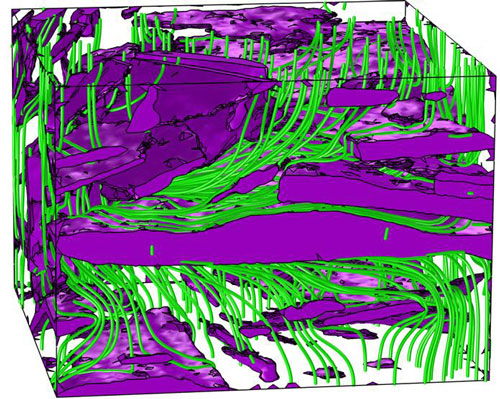| Feb 12, 2013 |
Understanding anti-corrosion paint
|
|
(Nanowerk News) Researchers at the London Centre for Nanotechnology (LCN) have revealed detailed 3D images of an important industrial coating that is used to reduce corrosion of ship hulls. The work ("Three-Dimensional Structure Analysis and Percolation Properties of a Barrier Marine Coating"), carried out in collaboration with international paints and coatings company Akzo-Nobel, allows the automatic identification of aluminium, talc, pigment and remaining filler components in the image, based solely on X-ray refractive data.
|
|
The high-resolution images were combined with detailed modelleing of the paint’s function, to produce two key insights. Permeability of the material to ions, one of the leading causes of corrosion, was found to be much reduced in the direction crossing the coating. Also, the passage of ions was seen to be blocked by the plate-like morphology of the aluminium component. The images show that these become aligned with the surface during application of the paint.
|
 |
| Cut out showing the locations of the Aluminium plates (purple) within a 10x10x10 micron block of the marine coating. The stream lines of the ion flow through the coating are shown (in green) to detour around the obstructions, acting to slow the corrosion.
|
|
The images were obtained using a 3D X-ray visualisation method, called X-ray "Ptychography-Tomography", developed at the Swiss Light Source in Villigen, near Zurich. The method is analogous to a 3D version of phase contrast microscopy – a revolutionary technique in light microscopy, which allowed the imaging of transparent biological samples such as bacteria. Ptychography-Tomography has recently been used by the Pfeiffer group in Munich to visualise the 3D arrangement of osteocytes in a bone and is expected to see widespread applications in nanoscience and technology.
|
|
Professor Ian Robinson, who led the LCN team, made these comments about the result: "The work of Bo Chen and colleagues represents a fine example of the modern scientific method, teamwork between industrial hi-tech materials development, international characterisation facilities and university-based theory and modelling. The characterisation facilities in Switzerland, an X-ray beam line with high X-ray coherence built onto a particle accelerator, are highly specialised and unique in the world. Yet they offer open access to visiting researchers for well-justified problems. This shared access approach allows centres like the Swiss Light Source to specialise their equipment to the extreme, whereby it becomes unique in the world. The authors of this paper have applied the method to a relevant industrial material and were able to go further by modelling its function as a barrier coating use to reduce corrosion and fouling of ship hulls."
|
|
The method and work is due to be discussed at the workshop on "Real and reciprocal space X-ray imaging" to be held on the 11th February at The Royal Society at Chicheley Hall, home of the Kavli Royal Society International Centre, Buckinghamshire, UK.
|

